Is investing in a reusable cup or bottle really going to lower your environmental footprint?
This is a valid question and there has been confusion around this topic as there are many differing opinions.
In this post I will answer three main questions:
1. What’s the environmental impact of disposable cups?
2. What’s the environmental impact of reusable cups?
3. When are reusable alternatives better than single use cups?
If you’re in a rush, you can jump to a section below, or head straight to the overall assessment.
THE BASICS OF COMPARING SINGLE USE VS REUSABLE
Before answering any questions it’s important to understand why this is even a debate. Varying opinions on whether disposable cups are worse or better for the environment than reusable alternatives stem from unfair comparisons.
A few reasons why people may be comparing apples to oranges:
- Types – different types of disposable cups (paper, plastic, styrofoam) have varying impacts. Likewise, so do their reusable counterparts. This makes it difficult to make blanket statements like “all disposable cups are worse than reusable alternatives”
- Focus – you can paint a different picture depending on which aspect of environmental impact you’re focusing on. Energy use, natural resource use, pollution, and emissions, are just a few of the different areas you can compare. To be fair, you have to consider the complete environmental impact of disposable vs reusable, not just one aspect.
- Other – Other variables such as the technology used to manufacture the cup or how long it traveled to get the place of sale also change the environmental impact.
The Key Indicators of Environmental Impact
There are several variables to compare when it comes to rating the overall environmental impact of a product. Here are the main 3 areas and some of the considerations of each:
- Production – What it takes to make the product
- Input of energy and natural resources
- Transportation of raw materials and finished product
- Emissions and other pollutants from manufacturing
- Use – How use of the product impacts humans or the environment
- Impact on human health
- Lifespan of the product
- Environmental impact of use (if any) – example: washing of reusable cups
- Post Use – How disposal of the product impacts the environment
- Pollution of natural environment
- Emissions from disposal (gasses from breakdown in landfill or incineration)
- Cost of recycling
The total impact of a product can be calculated using our simplified formula:
Total Environmental Impact = Cost of Production + Cost of Use + Cost of Post Use
The Key Performance Indicators
There are also several different types of environmental impact. The most common types and the causes they are linked to include:
Emissions – global warming, air pollution
Natural Resource Use – deforestation, biodiversity loss, global warming
Pollution – biodiversity loss, degradation of natural environment
Some people may weight one factor as more important than another depending on their opinions of which environmental issue is most pressing.
The most common comparison for environmental impact is energy used to create, distribute, and dispose of the product.
Energy input is considered to be the primary indicator of environmental impact because it is tied to almost all other factors. It takes natural resources such as coal to create energy and once burned it contributes to emissions that fuel global warming.
In this comparison of disposable vs reusable cups I will draw from several studies about energy use in each phase: production, use, and post use.
It’s important to note that there are other considerations when buying a product such as the social responsibility of the company producing it. I’ll touch on these considerations in my summary.
Cost of Production
In general, producing one disposable cup has a lower environmental impact than producing one reusable cup or bottle.
Measurement of Energy Input Needed (kJ/Cup) to Produce 1 Unit:
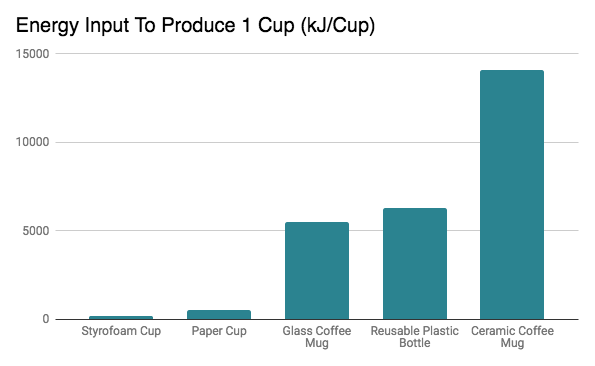
Producing a styrofoam or paper cup requires much less energy input than reusable alternatives such as plastic, glass, or ceramic.
This probably isn’t a big surprise to you. Disposable cups are smaller, lighter, and easier to make, while their counterparts require more input of resources and energy.
Proponents of single use cups may stop here and claim that disposables are more energy efficient and therefore more environmentally friendly. But the most critical evaluation happens in the next two phases: Use and Post Use.
In general, when comparing 1 cup to 1 reusable cup, the production of disposable cups is in fact more eco friendly.
Cost of Use
It’s clear that the production of one disposable cup has a lower impact than one reusable alternative. But if you use over 300 disposables in a year, doesn’t that add up to be a greater impact than using only one reusable cup?
To calculate and compare the average cost of use for disposable cups vs reusables we have to answer one key question:
How many disposables are equal to the continued use of one reusable alternative?
The quick answer: this number ranges from 6 to 127 depending on various factors such as the type of reusable cup and how it is used.
Key Considerations – Washing Cups
A key factor in this aspect of the environmental impact of disposable vs reusable comes down to washing.
While disposables have no energy input necessary for their use, reusables do. In order to continue reusing a glass, plastic, or ceramic cup it needs to be washed which will contribute to its overall environmental impact.
Of course, there are different ways to wash cups and some are more eco friendly than others.
In general, washing by hand is more energy efficient than using a dishwasher. And washing with cold water is more energy efficient than washing with hot water.
The safest estimate to use is the energy use of a common household dishwasher.
Cost of Use: Summary
Considering the energy input to produce and to wash we can calculate a “break even” point, where using a reusable cup becomes as efficient as using a disposable cup.
The formula:
Break even number of uses = (Energy of Reusable cup)/(Energy of Disposable cup – Energy of wash)
The results:
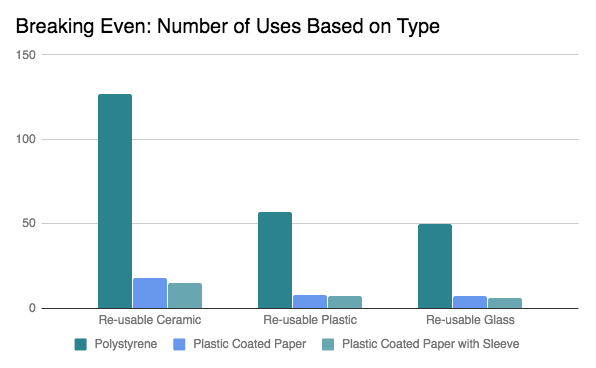
Main Takeaways
- Glass and plastic are the most energy efficient materials for reusable cups
- When replacing paper cups it takes less than 20 uses to become more efficient
- When replacing styrofoam cups (because energy input for this type is so low) it takes up to 127 uses
Most comparisons of disposable vs reusable cups end here. Although we’ve already determined that reusable cups are more eco friendly after continued use, we still don’t have the whole story.
What if all disposable cups are recycled and their materials are used over and over again?
We need to consider the environmental impact of disposal to have a complete understanding of how disposables stack up to reusables.
Cost of Disposal (post use)
The main factor to consider in disposal is how often cups are disposed of and how. Are they recyclable? What’s the impact of recycling them, sending them to the landfill, or other outcomes?
Are disposables recyclable?
Disposable cups are disposed of in mass and the most common type, used for coffee, are difficult to recycle. The vast majority of paper cups we use daily for takeaway drinks have a plastic lining in them that prevents to paper cup from becoming saturated and falling apart.
This plastic lining must be separated from the paper in the recycling process which makes recycling them difficult and costly. In fact, most recycling centers are not equipped to process them.
The result: Unfortunately right now only about 1% of disposable cups are recycled.
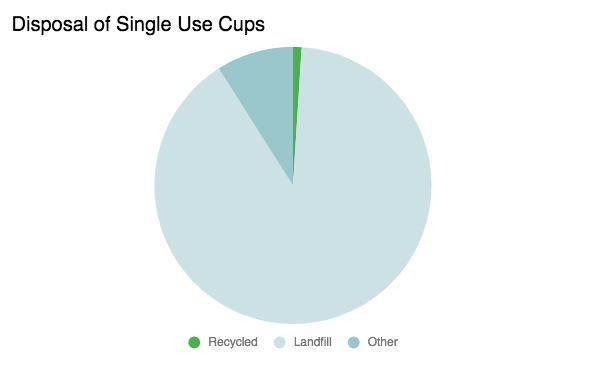
What is the cost of disposing single use cups?
It’s difficult to calculate the cost of disposing single use cups because of various scenarios. However, we should consider the following:
- Collecting and transporting used cups is energy intensive (think trash trucks)
- Once in a landfill cups may breakdown slowly in the right conditions but their plastics will take hundreds of years resulting in landfills that are wastelands
- Greenhouse gas release from landfills is a major contributor to global warming
- Cups that don’t make it to landfills pollute the natural environment
- Incinerating disposable waste will recoup some of the energy but also results in emissions that contribute to global warming and air pollution
- The sheer volume of disposable cups thrown away on a daily basis is hard to fathom (Starbucks alone produces 4 Billion each year)
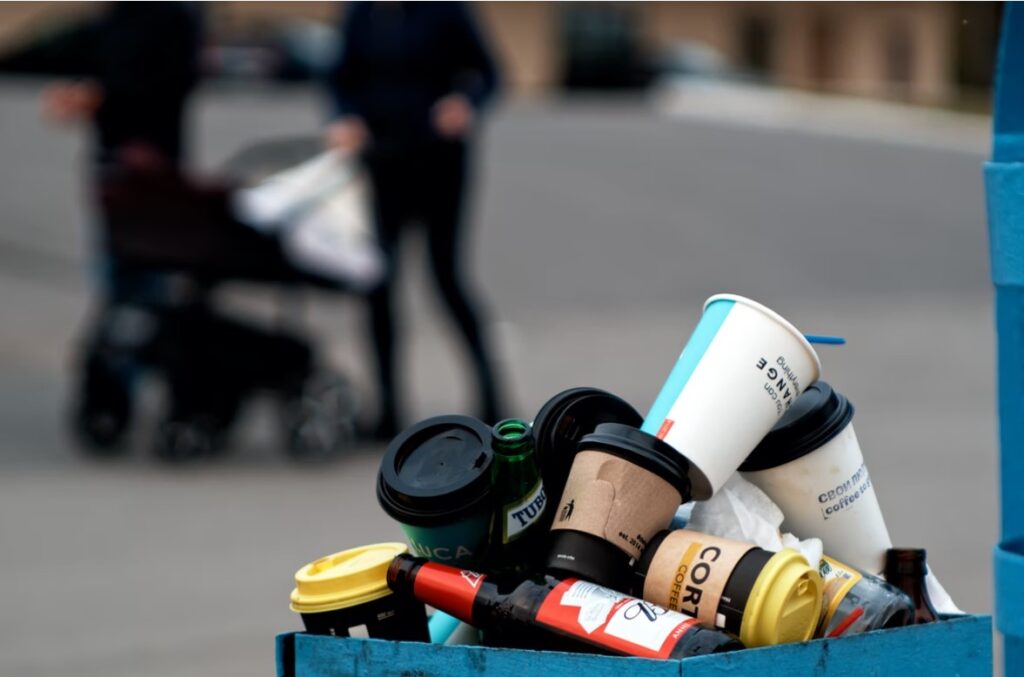
How do reusables stack up?
Ceramic Cups – very little to no recycle potential but can last to thousands of uses if cared for and has little to no environmental impact in landfills
Plastic Alternatives – Many plastic alternatives can be recycled and will last for thousands of uses
Glass Cups – Can be recycled, will last for thousands of uses, and has little to no negative environmental impact in landfills
The bottom line
Reusable cups have a longer lifespan so their overall disposal impact is much lower than single use cups.
Most reusable cups can be recycled. Glass and ceramic are less of a threat to the natural environment because they will break down over time and do not contain synthetic chemicals, unlike styrofoam or the plastic lining of paper cups which do not biodegrade.
Disposal of single use cups poses other threats such as the cost of waste collection and the accumulation of these products in our oceans, when they are not taken to the landfill or incinerated.
OVERALL ASSESSMENT OF SINGLE USE VS REUSABLE
While it takes more energy to produce reusable cups, because they have a longer lifespan their overall environmental impact is much less than disposable cups.
Each type of disposable and reusable cup has its own variations in its impact on the environment. Some are better than others.
In general, the number of uses needed for a reusable bottle to be more eco friendly ranges from 6 to 127.
Reusable Options Overview
Glass cups are the best alternative. If you’re foregoing paper coffee cups by using a glass mug, you can be having a positive environmental impact in as few as 6 uses.
Reusable plastic cups are close behind glass. The break even point for reusable plastic cups can be as low as 7 uses.
Ceramic cups are also a good alternative but it will take more uses for them to become more environmentally friendly than disposable cups (as few as 15).
Disposable Options Overview: Plastic Cups vs. Paper Cups
If you need to use a disposable cup, you’re often left to choose between paper and plastic cups. As we discussed above, there are many factors that determine the true environmental impacts of each type of cup.
Paper cups can biodegrade. This lowers their environmental impact, as they breakdown over time, while plastic cups sit in landfills for years. However, the carbon footprint of paper cups is higher than plastic cups, and uses more energy to produce.
Plastic cups (especially Styrofoam cups, a type of plastic) do not biodegrade, but has a lower carbon footprint and uses less energy than a paper cup to produce.
Another disposable cup option is the reusable aluminum cup, which can be recycled over and over again, and is typically made with more recycled content than paper or plastic cups. However, aluminum production releases a large amount of greenhouses gases and waste.
Ultimately, there is no clear winner among disposable cups, as the biodegradability of paper cups is mitigated by the high energy costs to produce them.
While reusing glass cups is ultimately the most environmentally sound option, the best option for disposable cups is one made from recycled materials, which are environmentally beneficial as they use less raw material to produce.
Main Takeaway
When assessing the sustainability of disposable cups vs reusables, it’s clear that reusables are more eco friendly when used repeatedly.
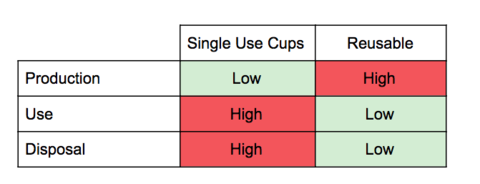
Although the impact of the production of single use cups is lower than reusables, the impact of their use and disposal is much higher.
Every use of a reusable cup is one sip closer to a more sustainable world.
If you’re ready to reduce your reliance on single use cups, check out our recommended reusable alternatives.
Resources
1. Energy and CO2 Analysis of Drinking Cups
2. Disposable Coffee Cup Waste Reduction Study

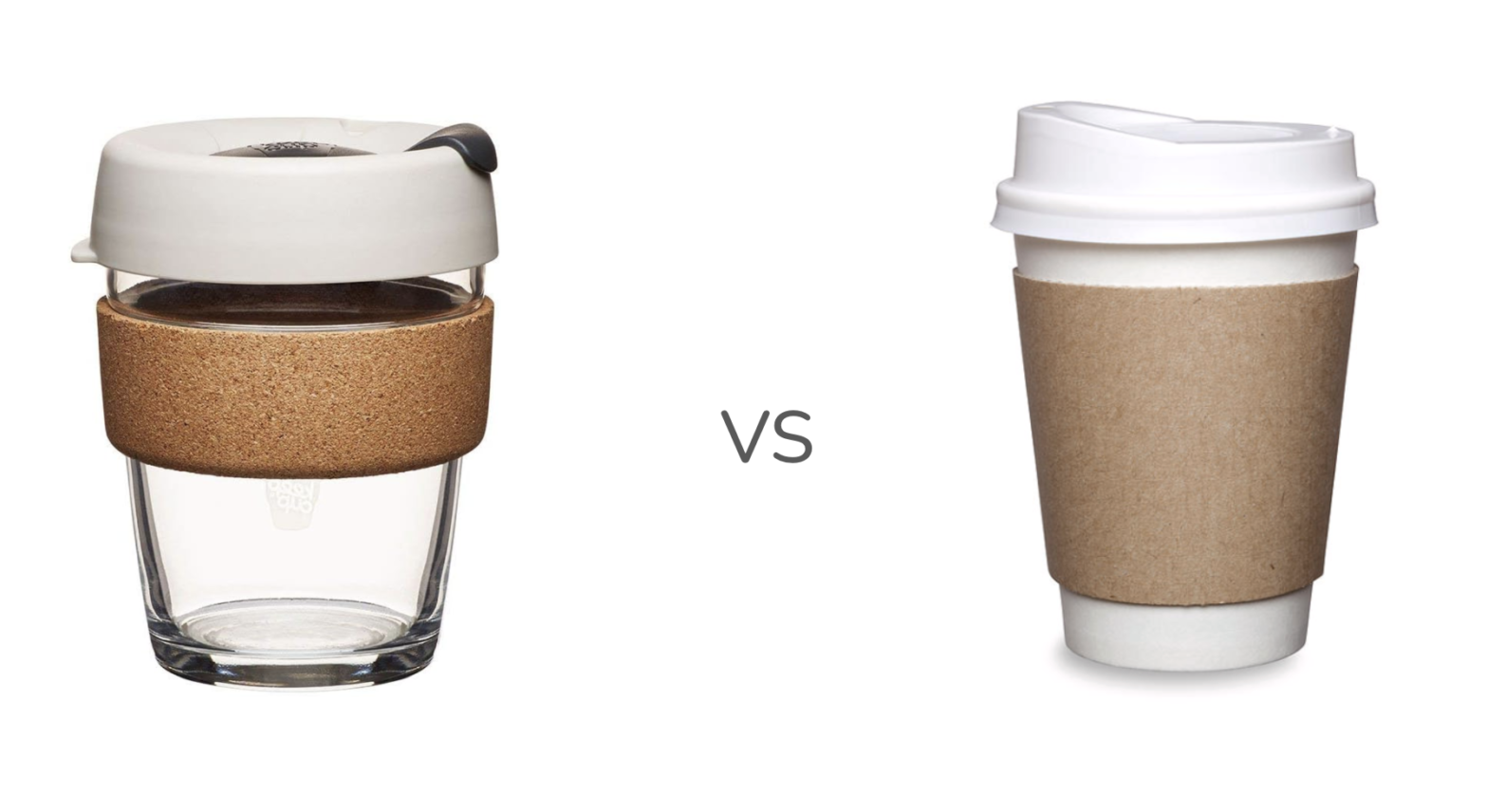
Can you provide some references for the facts cited in your article about single use vs. reusable cups?
Hi David, a very interesting read. However you failed to mention the environmental impact that a plastic reusable cup will have in a landfill, unlike glass or ceramic, it will leak toxins and chemicals into the soil and water. Surely your conclusion should be that the nest reusable alternatives are glass or ceramic? For the good of the environment overall?
Hi there! I greatly appreciate your thorough and thoughtful assessment of this topic. I’d like to take a look at your sources as I’m working on a project regarding this topic as well, just having some trouble seeing the PDFs you linked – would you be willing to email me regarding this? Thank you for your time!!!